For Stillness
Analog Interaction Design in a Digital World
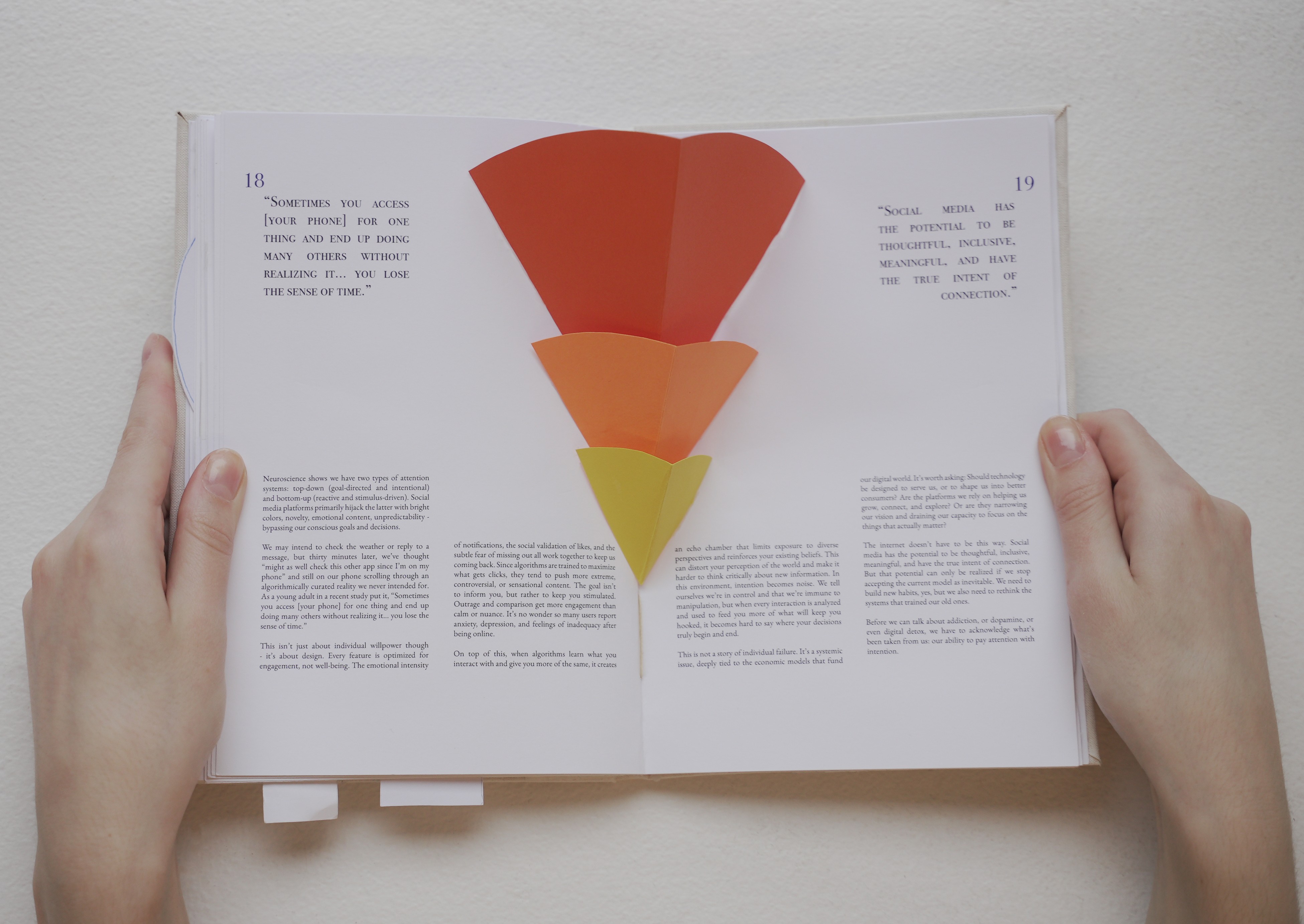
Role
Product + Interaction Design
Visual Design
Research
Timeline
January – May 2025 (4 months)
Team
Just me!
Overseen by Dr. Harpreet Sareen and Andrew Zornaza
Tools
Adobe Illustrator
Adobe Photoshop
Adobe InDesign
Midjourney AI
Problem
How might we highlight our low attention span from technology usage and inspire people to choose "slow entertainment" for a balanced dopamine threshold?
The inherent nature of social media itself is not bad, it can connect us with friends and loved ones far away, but our relationship with it needs to be modified. There are many conversations spreading awareness in today’s society that shed light on the psychological principles that social media companies exploit and strategies they use to retain a user’s attention for their profit.
However, there is much less dialogue around what’s actually happening in a user’s brain on a neurological level from social media use and the big-picture consequences that it could have on a user’s life.
Solution
Analog user experience of interaction design that creates a meta-commentary on the scattered attention patterns that social media fosters.
This project deliberately calls back to a time when entertainment, learning, and interaction were slower and more reflective. By creating a modern educational tool through the oldest form of user experience, it offers stillness, focus, and intentional interaction as the antithesis of our fast-paced digital world.
The target audience is individuals who scroll without knowing why rather than participating in hobbies that bring them joy or nourishing meaningful relationships. Through entry points spanning scientific concepts about dopamine processing, attention fragmentation, and storytelling, it is evident that the goal isn't to reject technology altogether, but rather to remind readers what deep engagement feels like without constant artificial stimuli.
Research
Multi-faceted research combining behavioral observation with quantitative and creative methods.
The following four research strategies presented below revealed digital addiction's physical grip - participants automatically reach for phones and can't tolerate content longer than a minute. One described being 'wired' for short dopamine hits without even knowing that concept is what they were describing. This dependency breeds shame, making honest conversations about usage nearly impossible and deepening the cycle.
1
Subway Observations
How many people scroll on their phones when no external stimuli are present? (Spoiler: those younger than 40 do 60-75% of the time)
2
Free-writing
Social media users write about their thoughts and feelings about social media for 2 minutes straight
3
Drawing
Users draw how they feel during and after social media usage. The drawings were also fed into Midjourney AI for high-quality images in the book.
4
Structured 1:1 Interviews
What issues do users face and positive/negative feelings do they have towards social media, personal tech usage, and knowledge on the psychology of design?
On the physical side of the pop-up book, I researched pop-up history as the origin of interaction design and studied iconic mechanisms to incorporate (pop-ups date back to 1270!). For educational content within the book, I explored scientific papers on dopamine receptors, social media algorithms, and their roles in addiction and attention studies. This involved understanding not just how those topics intersect, but where they diverge to structure them into distinct chapters.
Iterations and User Testing
Trying to evoke an emotional response through written language and interactions with paper.
Prototype 1: My first prototype was in the form of a small booklet in which I drew and wrote in by hand. It featured very direct questions to the reader and references to popular social medial culture. During testing, users responded very positively to the book, citing that the data visualization specifically evoked strong emotions of shock in them and that they felt it elicited an important conversation. They liked that it was a hand-held book rather than something digital.
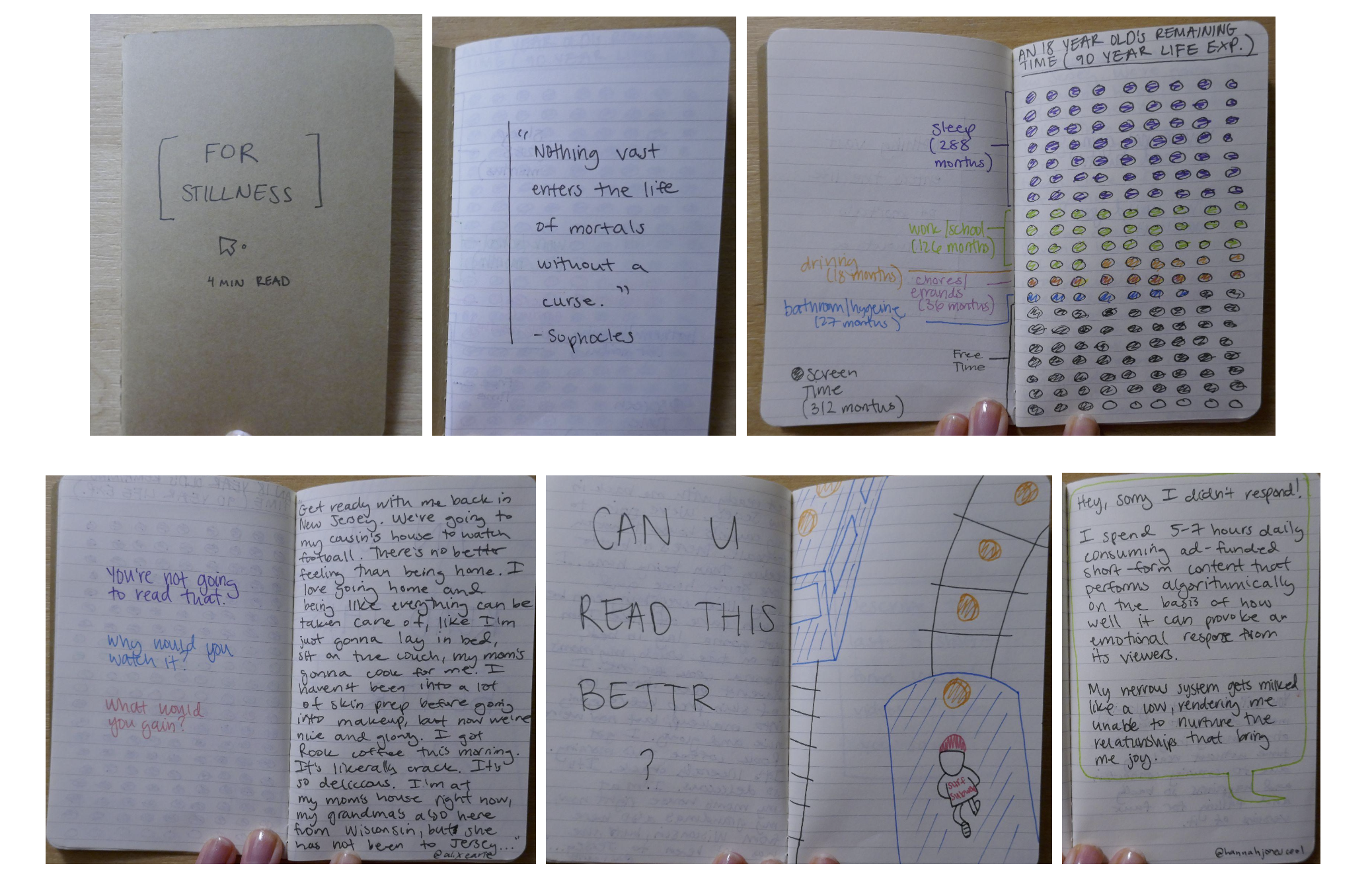
Prototype 2: I hand-bound a physical book from scratch and glued into it prints of InDesign pages. The text was initially all Lorem Ipsum, but users were told what the book’s content would be to create a deeper discussion on dopamine and the manipulation of technology. My main goal with this prototype was to get a sense of the bigger picture as to what resonates the best with the user in terms of flow, pop-up engagement, and whether it still evokes an emotional yet reflective response. Users felt engaged by the pop-ups, but that the organization of the content and its scope needed further ideation.
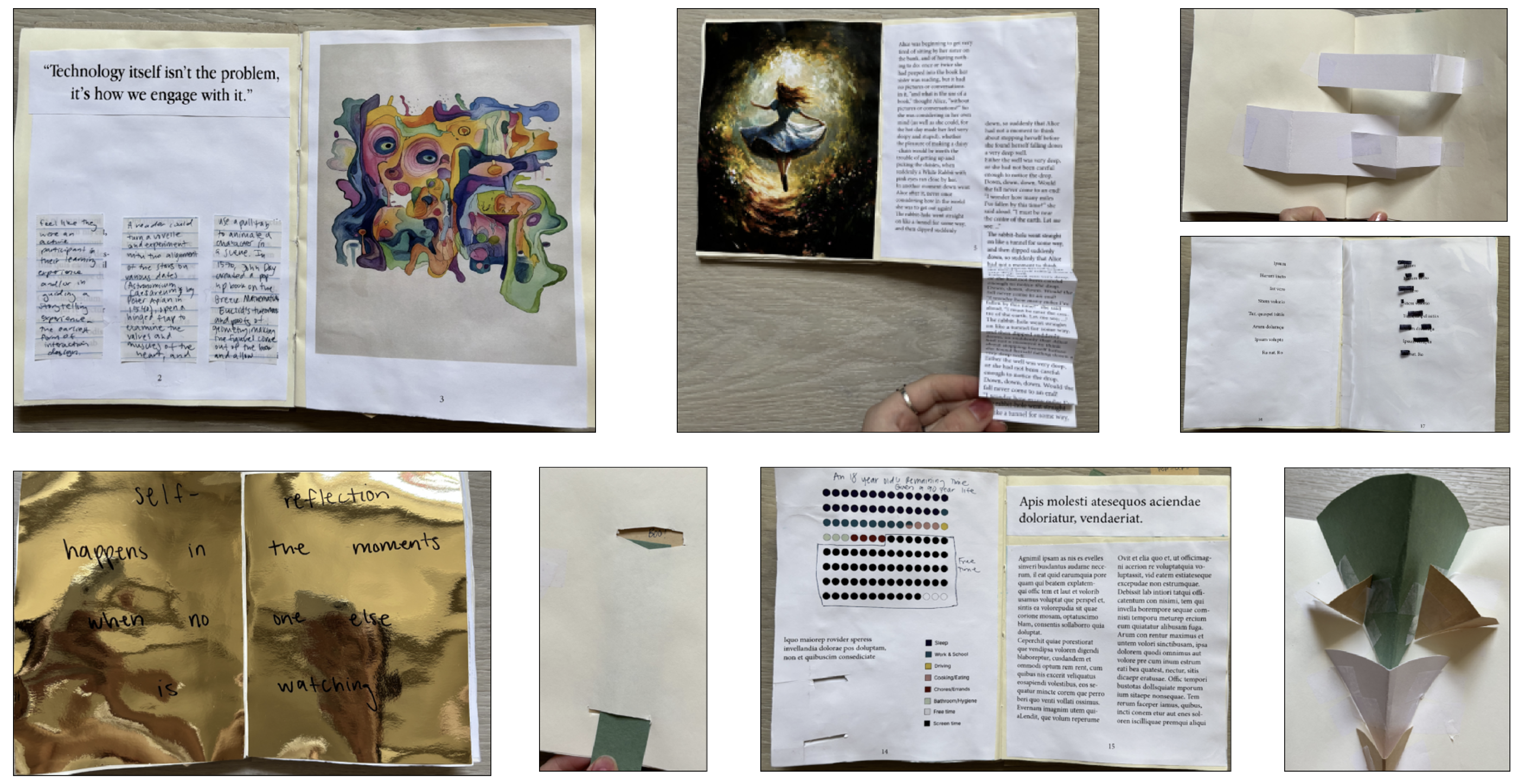
Prototype 3: The third prototype had no testing, but was rather centered around trying to figure out where the pop-ups should go and both how the text should be moved around in order to accommodate them and what pop-ups could best compliment the page’s content and intent. To make a pop-up on a specific page, you have to leave the next two pages blank to be glued together to accommodate for its mechanisms to function, so it was important to be meticulous about that division.
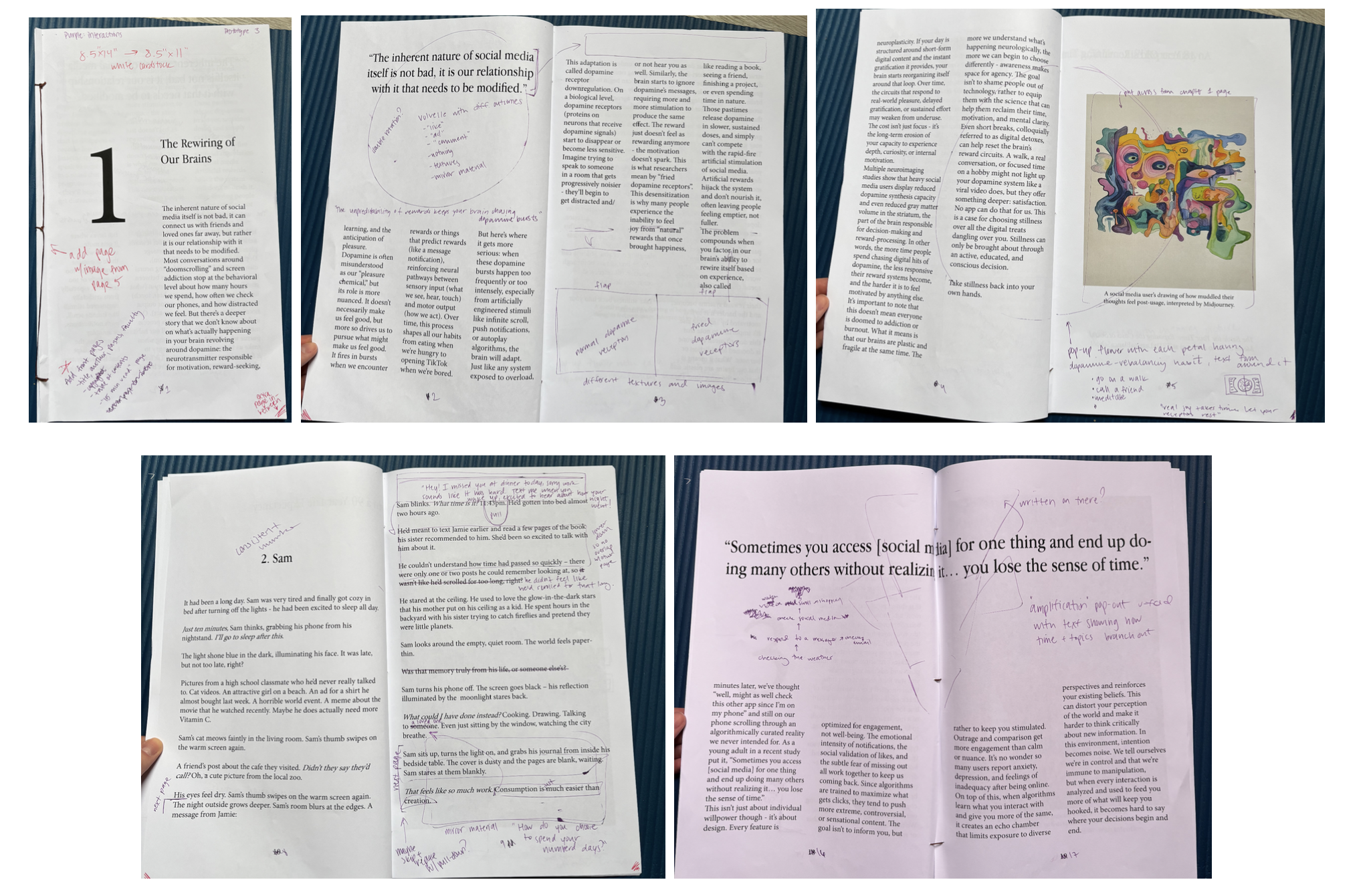
Crafting
Stepping out of my comfort zone.
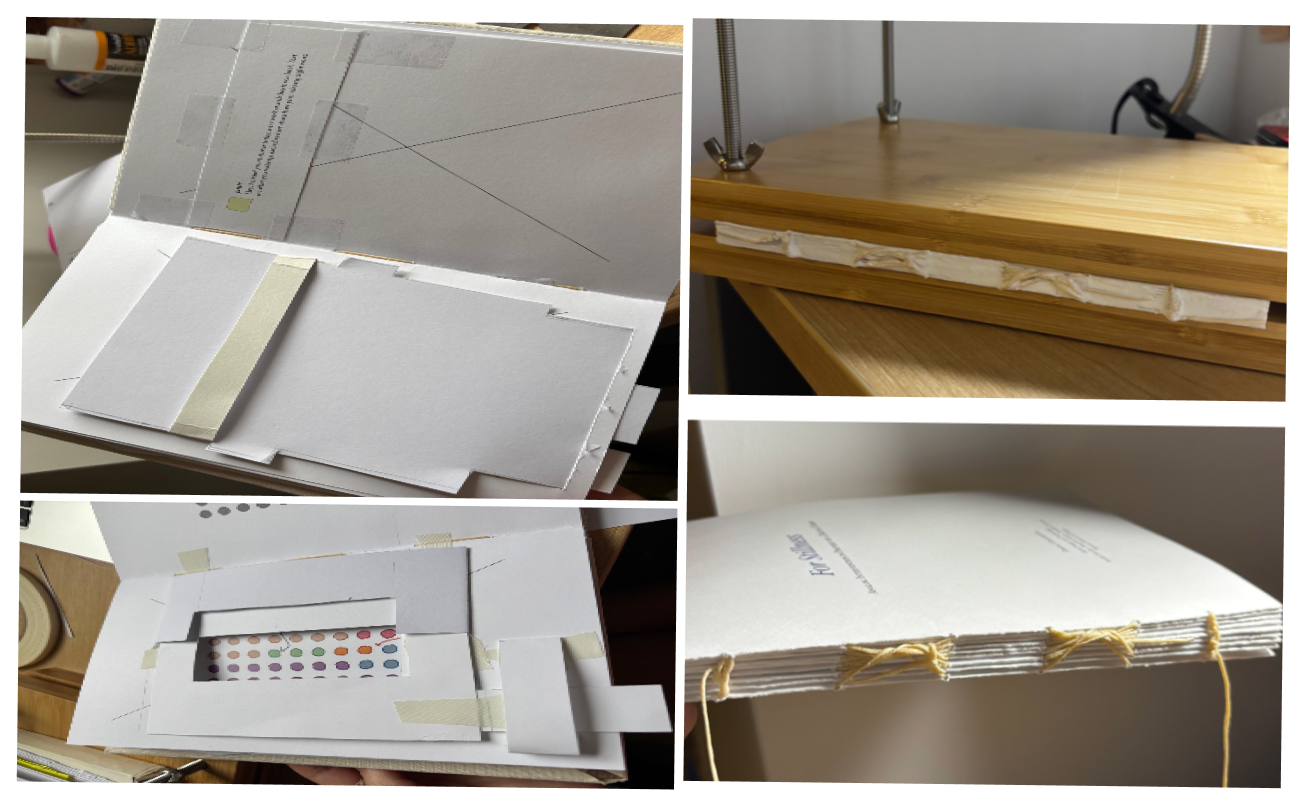
The book was perfect-bound by hand. Its construction entailed the following materials: book cloth, cardboard, cardstock paper (both colored and white), neutral pH adhesive glue, binding ribbon, awl, brush, bone folder, wax thread, curved needles, Exacto knife, rotary cutter, light gel filter sheets, book binding tape, Lineco archival document repair tape, Scotch tape, and a book press.
Final Product
A purposeful act of resistance against the commodification of attention.
The book is divided into four chapters of different topics: “The Rewiring of Our Brains” on dopamine, “The Universal Experience” as a short fictional story based on the user interviews, “The Architecture of Distraction” on attention and the algorithm, and “Intentional Interaction” as a brief history of interaction with a call to action to make active choices.
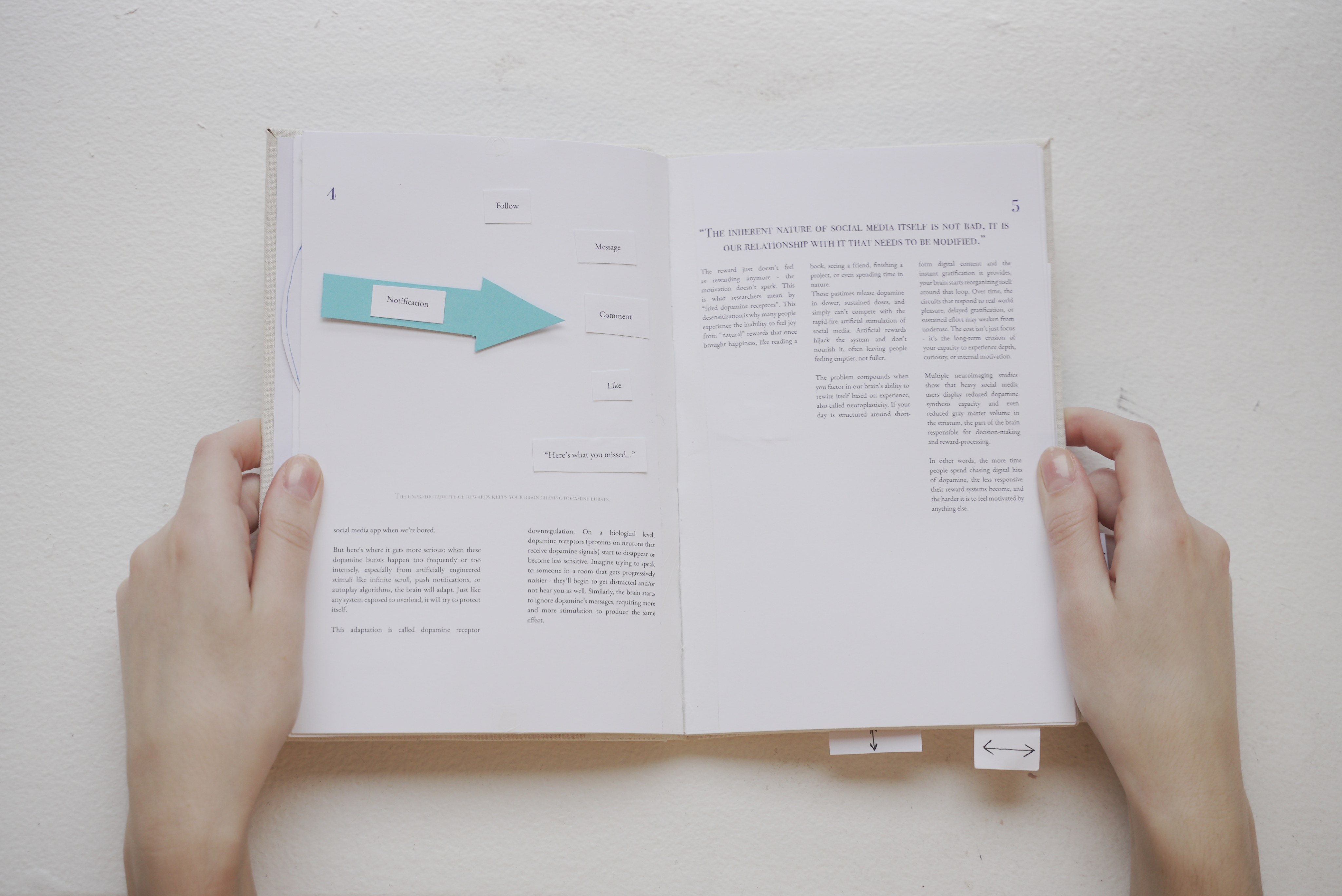
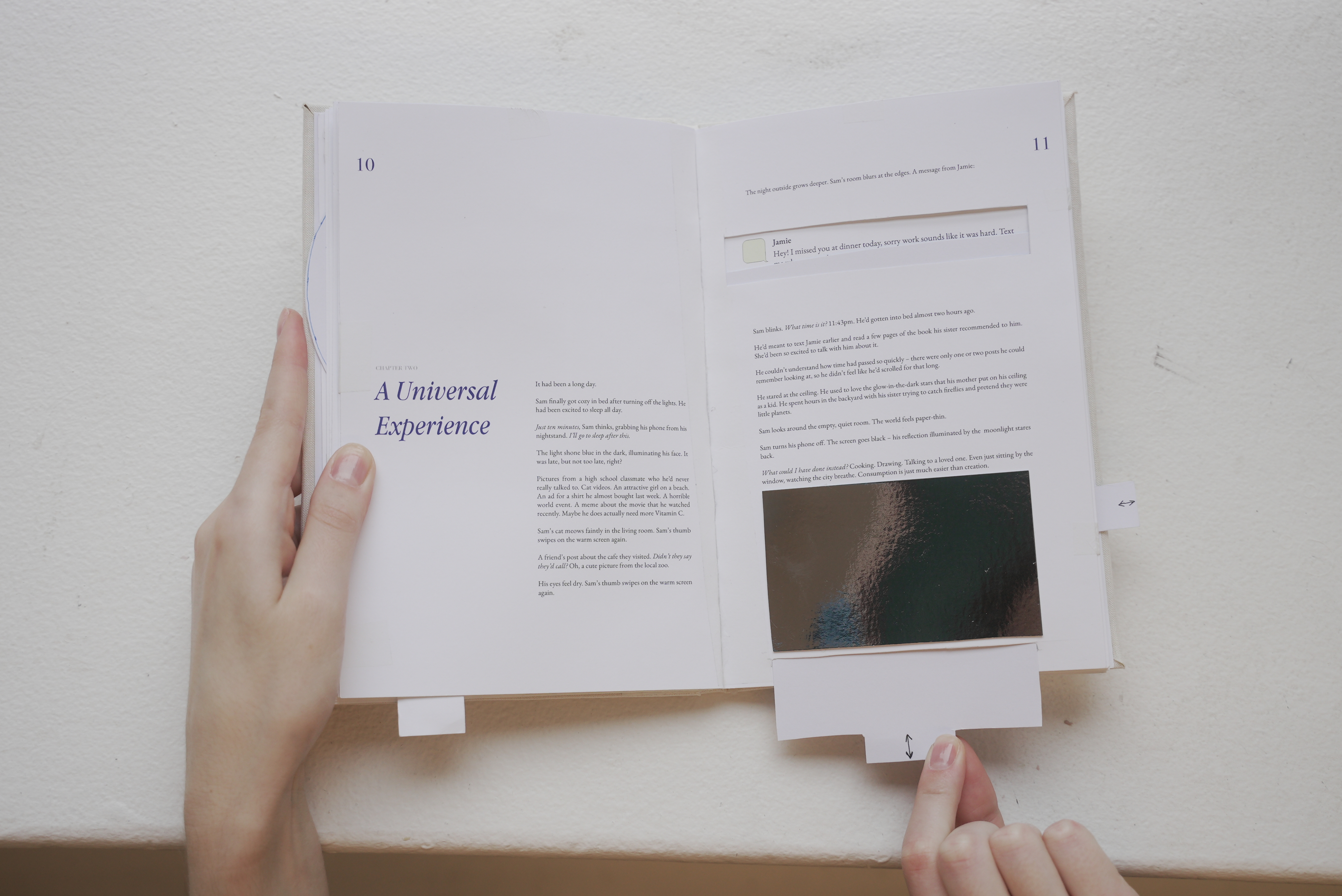
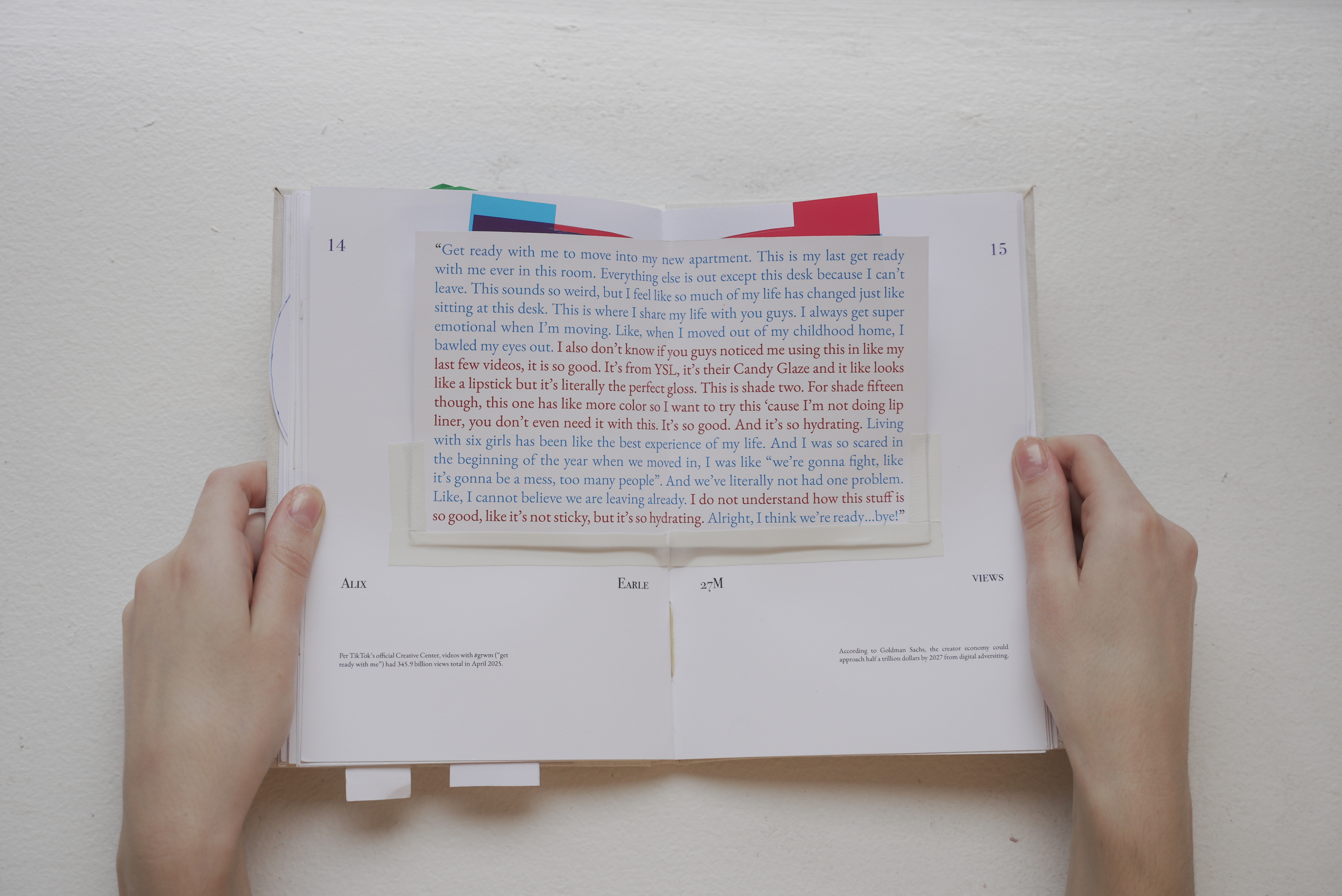
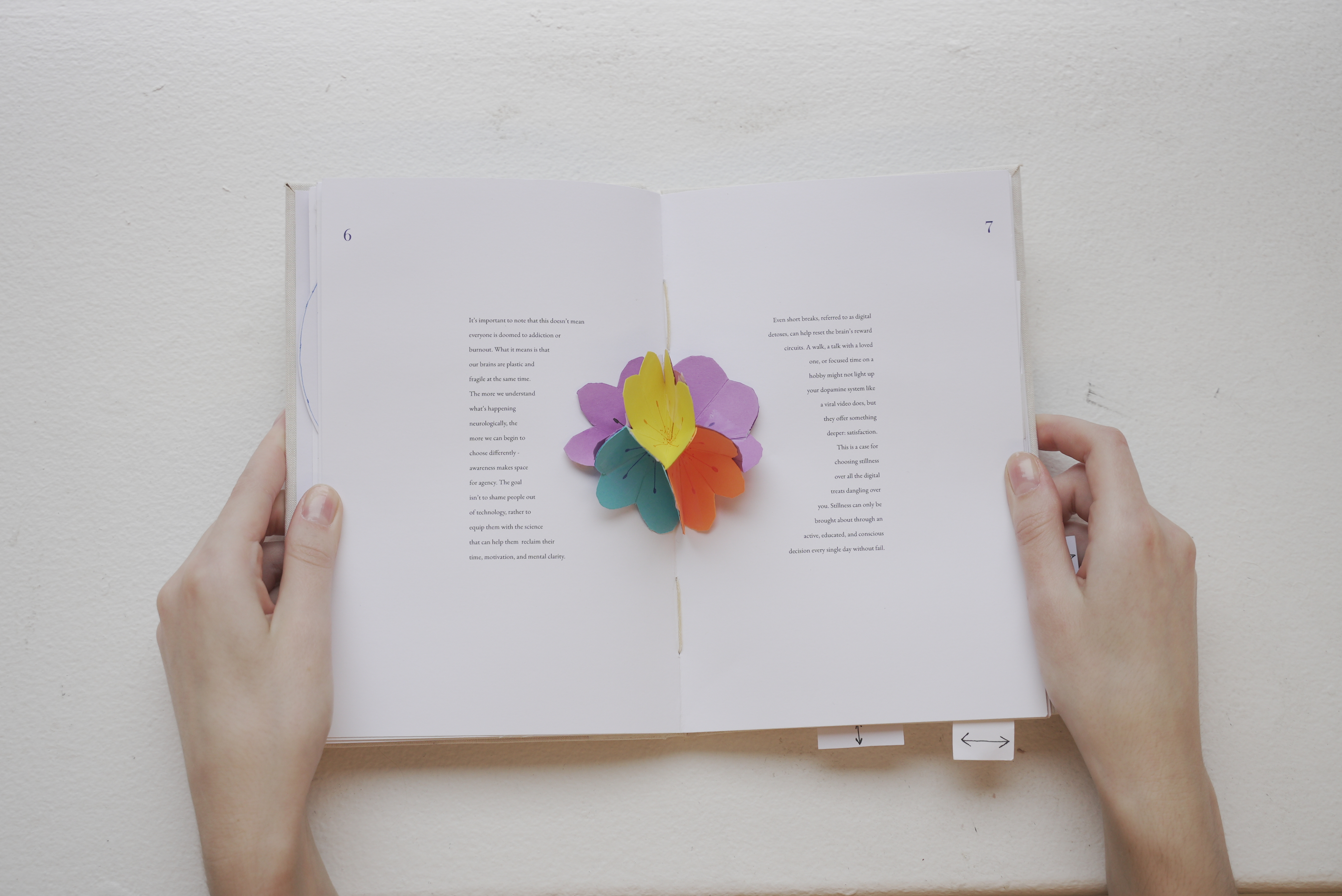
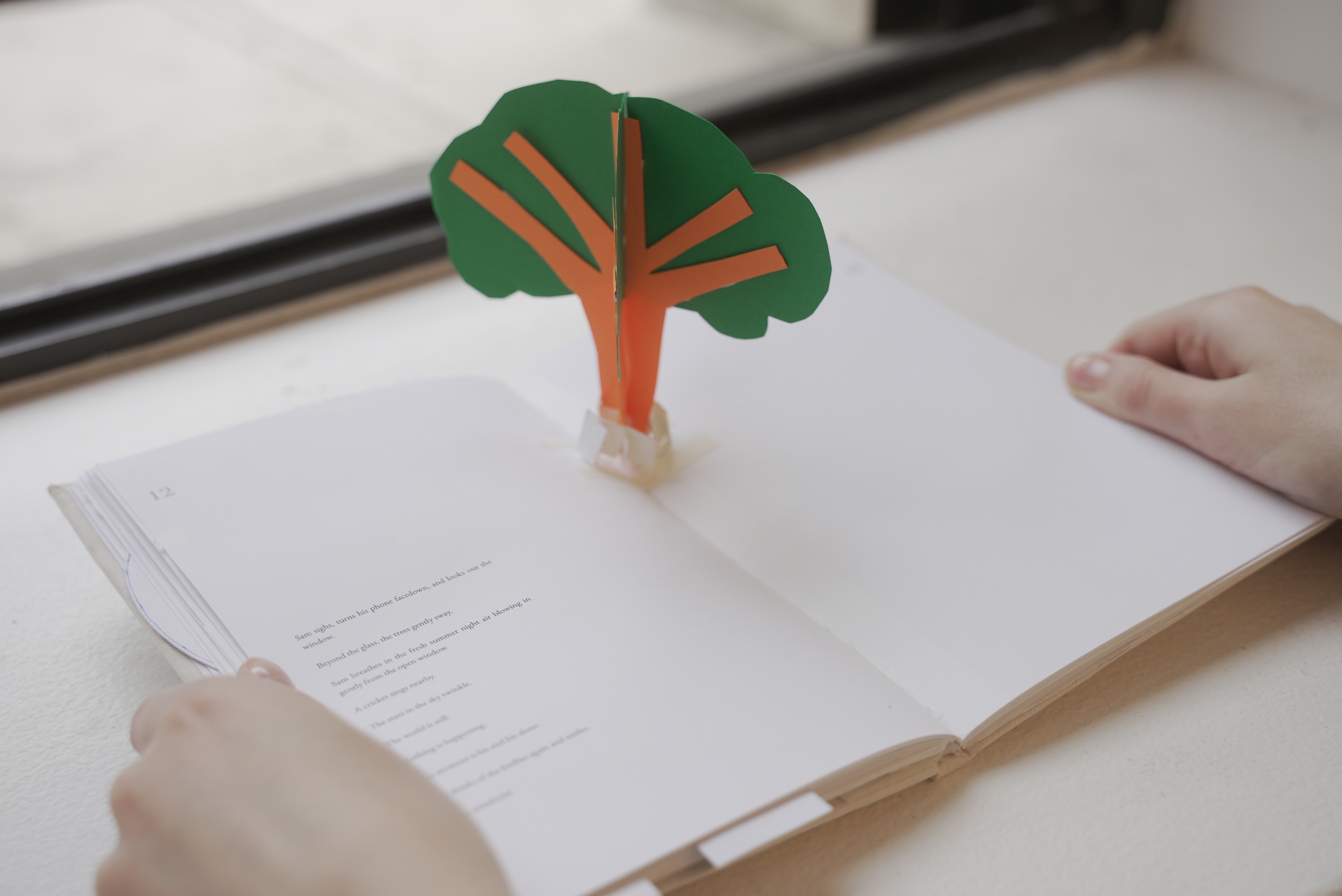
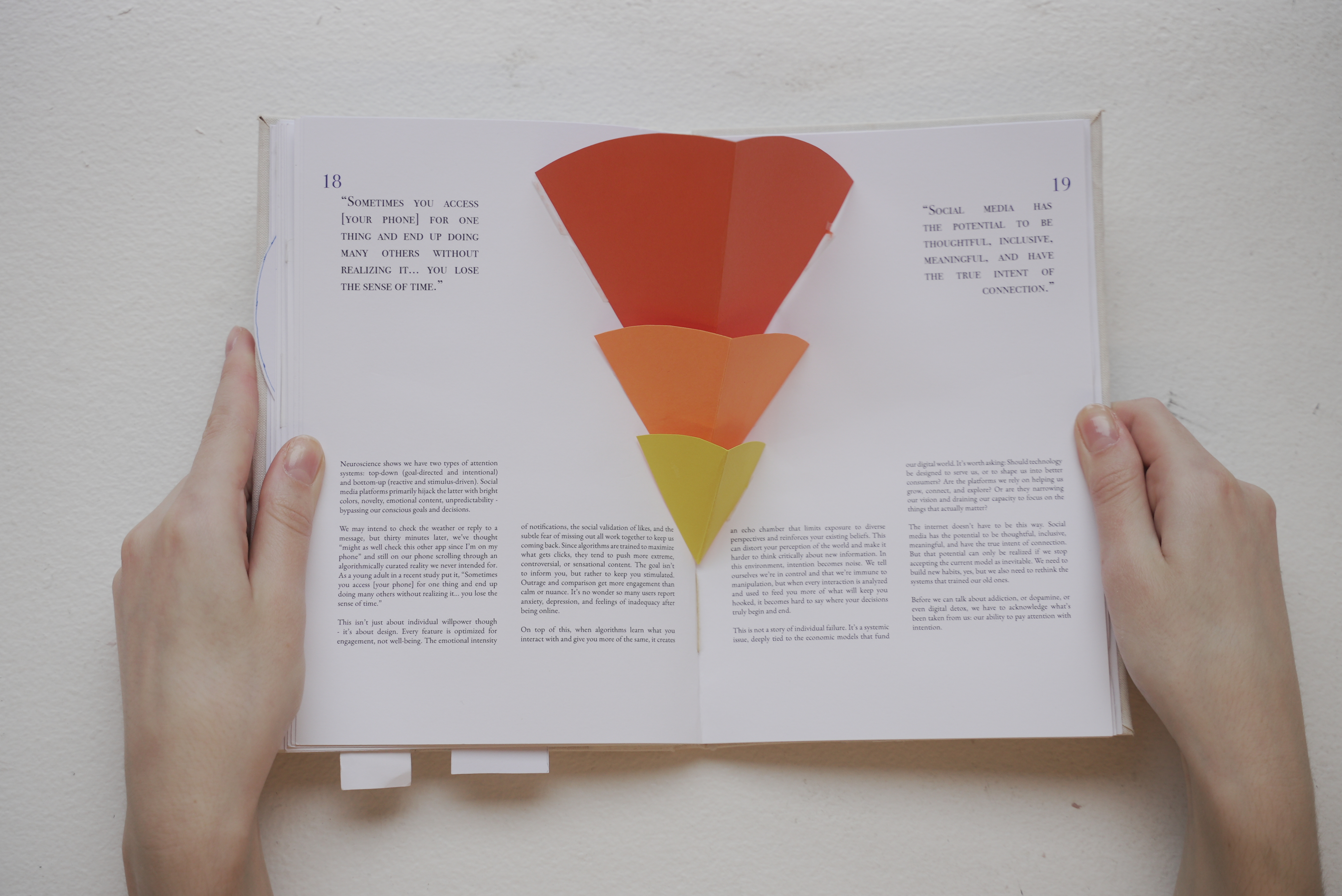
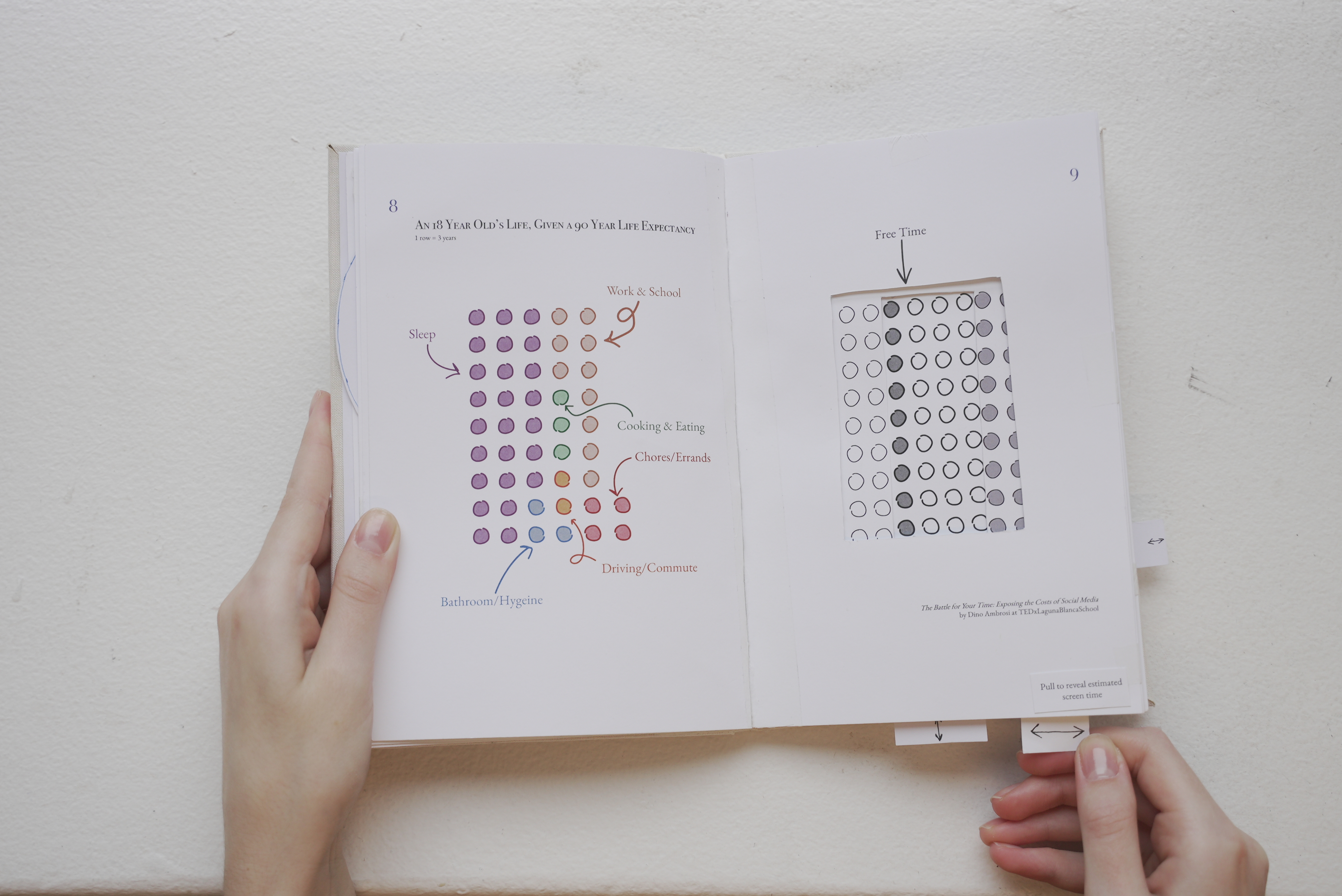
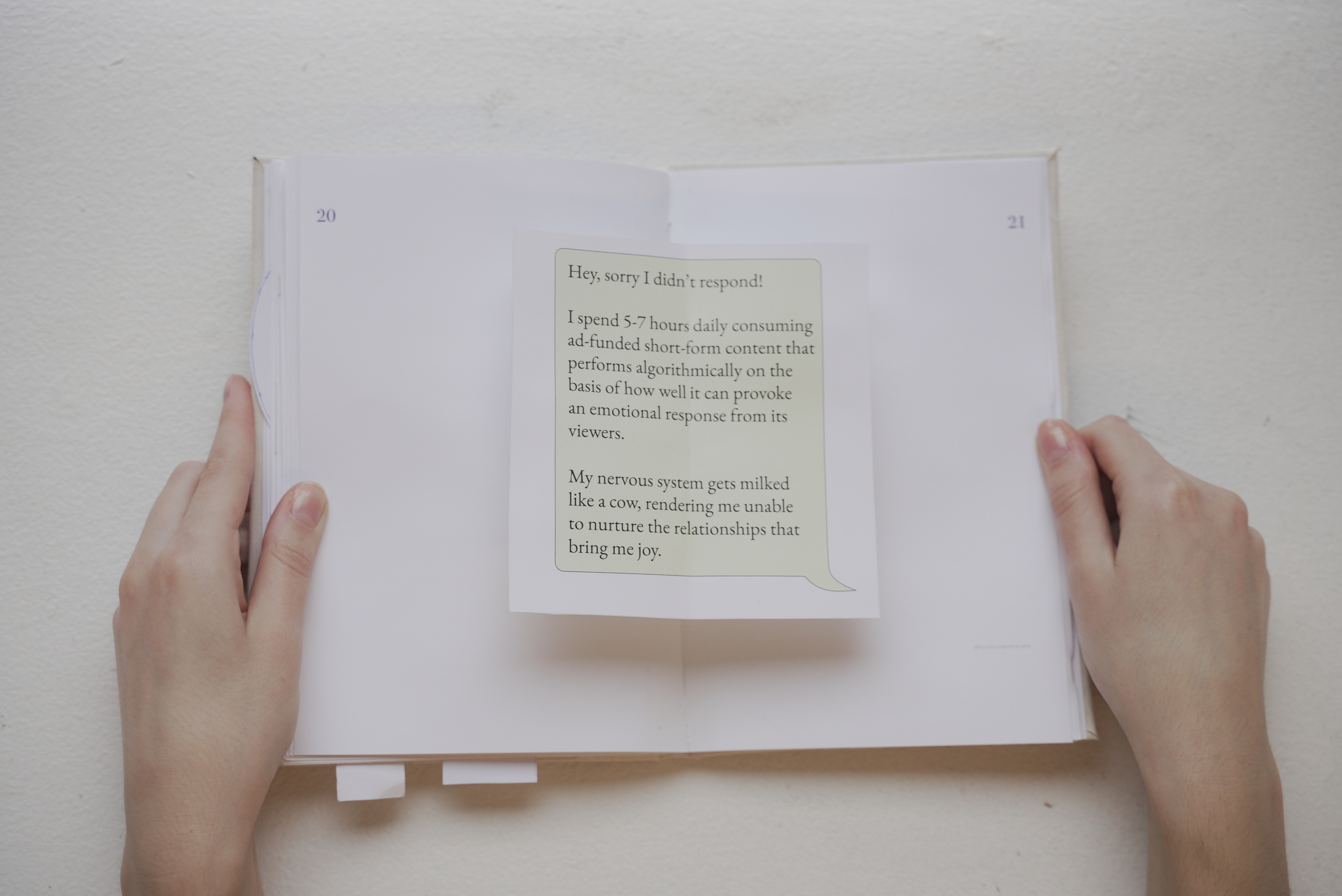
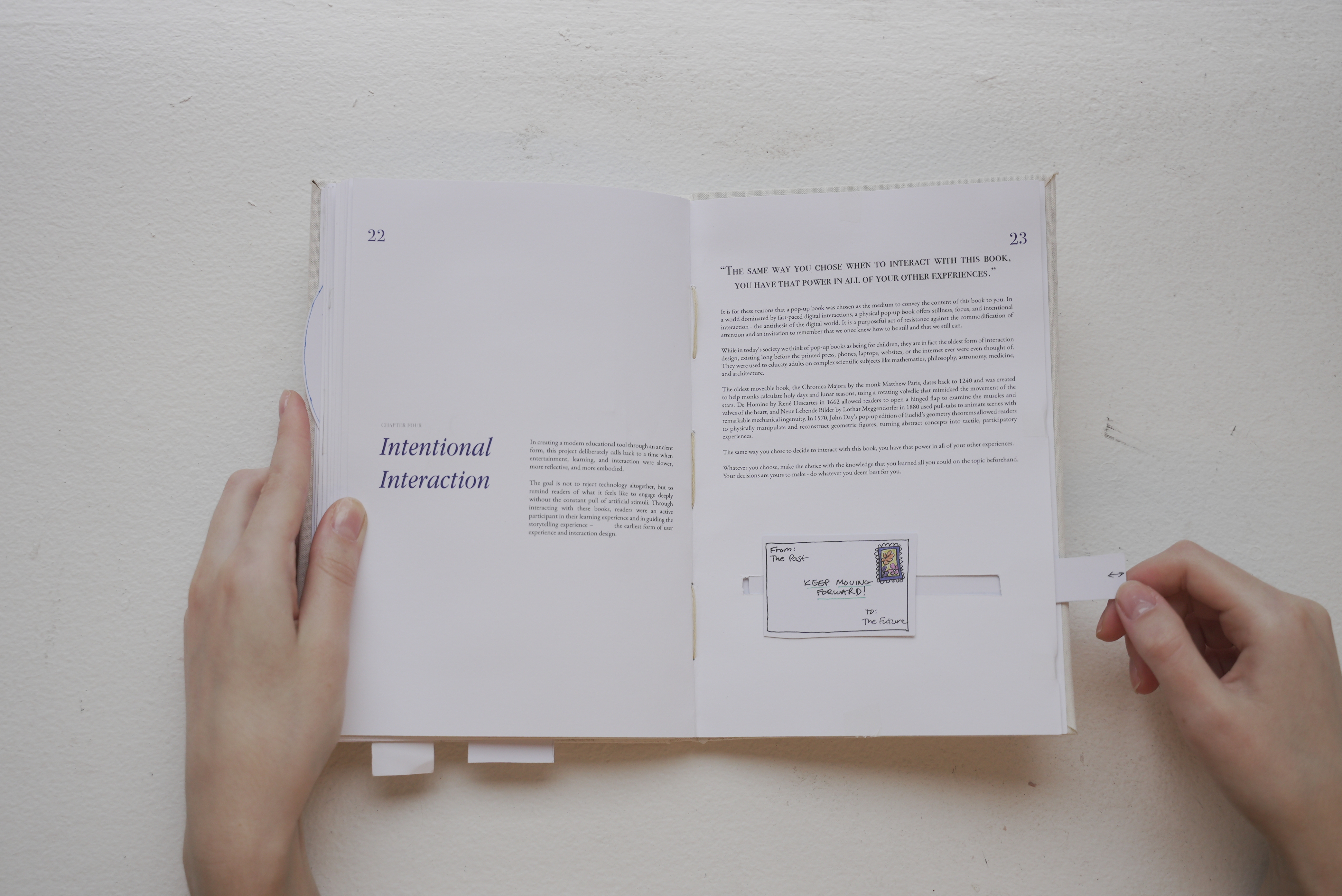
Reflection
Exploring analog space and design as a digital designer.
The user testing with the final product is overwhelmingly positive. The phrases “woah” and “I love this” were said a lot, with lots of smiles at the pop-ups. More long-term testing is needed with users that have the time to read it in full to predict the project’s full success and impact, but as of now based on testing in combination with conversations had with users on the topic afterward, it is very promising.
This project was an absolute labor of love and I am so proud of the outcome. Going into it, my goal was to expand on my visual design skills through designing book page layouts — I achieved that and so much more. As a digital designer, this was a huge jump outside of my comfort zone; the physical toll of craft aside, this may have been the most difficult project I’ve worked on due to the journey into the analog and unknown.
In the end though, not only did I get to explore a new medium, but alongside that came exploring a new way of thinking about design and user experience which I believe will strengthen any and all projects I have the honor of working on in the future.
I cannot thank the Parsons School of Design faculty that oversaw this project enough — this project would not be possible without the support, guidance, and discussions with Dr. Harpreet Sareen and Andrew Zornaza had with me. I am honored to be your student!
For Stillness
Analog Interaction Design in a Digital World

Role
Product + Interaction Design
Visual Design
Research
Timeline
January – May 2025
(4 months)
Team
Just me!
Overseen by
Dr. Harpreet Sareen and Andrew Zornaza
Tools
Adobe Illustrator
Adobe Photoshop
Adobe InDesign
Midjourney AI
Problem
How might we highlight our low attention span from technology usage and inspire people to choose "slow entertainment" for a balanced dopamine threshold?
The inherent nature of social media itself is not bad, it can connect us with friends and loved ones far away, but our relationship with it needs to be modified. There are many conversations spreading awareness in today’s society that shed light on the psychological principles that social media companies exploit and strategies they use to retain a user’s attention for their profit.
However, there is much less dialogue around what’s actually happening in a user’s brain on a neurological level from social media use and the big-picture consequences that it could have on a user’s life.
Solution
Analog user experience of interaction design that creates a meta-commentary on the scattered attention patterns that social media fosters.
This project deliberately calls back to a time when entertainment, learning, and interaction were slower and more reflective. By creating a modern educational tool through the oldest form of user experience, it offers stillness, focus, and intentional interaction as the antithesis of our fast-paced digital world.
The target audience is individuals who scroll without knowing why rather than participating in hobbies that bring them joy or nourishing meaningful relationships. Through entry points spanning scientific concepts about dopamine processing, attention fragmentation, and storytelling, it is evident that the goal isn't to reject technology altogether, but rather to remind readers what deep engagement feels like without constant artificial stimuli.
Research
Multi-faceted research combining behavioral observation with quantitative and creative methods.
The following four research strategies presented below revealed digital addiction's physical grip - participants automatically reach for phones and can't tolerate content longer than a minute. One described being 'wired' for short dopamine hits without even knowing that concept is what they were describing. This dependency breeds shame, making honest conversations about usage nearly impossible and deepening the cycle.
1
Subway Observations
How many people scroll on their phones when no external stimuli are present? (Spoiler: those younger than 40 do 60-75% of the time)
2
Free-writing
Social media users write about their thoughts and feelings about social media for 2 minutes straight
3
Drawing
Users draw how they feel during and after social media usage. The drawings were also fed into Midjourney AI for high-quality images in the book.
4
Structured 1:1 Interviews
What issues do users face and positive/negative feelings do they have towards social media, personal tech usage, and knowledge on the psychology of design?
On the physical side of the pop-up book, I researched pop-up history as the origin of interaction design and studied iconic mechanisms to incorporate (pop-ups date back to 1270!). For educational content within the book, I explored scientific papers on dopamine receptors, social media algorithms, and their roles in addiction and attention studies. This involved understanding not just how those topics intersect, but where they diverge to structure them into distinct chapters.
Iterations and User Testing
Trying to evoke an emotional response through written language and interactions with paper.
Prototype 1: My first prototype was in the form of a small booklet in which I drew and wrote in by hand. It featured very direct questions to the reader and references to popular social medial culture. During testing, users responded very positively to the book, citing that the data visualization specifically evoked strong emotions of shock in them and that they felt it elicited an important conversation. They liked that it was a hand-held book rather than something digital.

Prototype 2: I hand-bound a physical book from scratch and glued into it prints of InDesign pages. The text was initially all Lorem Ipsum, but users were told what the book’s content would be to create a deeper discussion on dopamine and the manipulation of technology. My main goal with this prototype was to get a sense of the bigger picture as to what resonates the best with the user in terms of flow, pop-up engagement, and whether it still evokes an emotional yet reflective response. Users felt engaged by the pop-ups, but that the organization of the content and its scope needed further ideation.

Prototype 3: The third prototype had no testing, but was rather centered around trying to figure out where the pop-ups should go and both how the text should be moved around in order to accommodate them and what pop-ups could best compliment the page’s content and intent. To make a pop-up on a specific page, you have to leave the next two pages blank to be glued together to accommodate for its mechanisms to function, so it was important to be meticulous about that division.

Crafting
Stepping out of my comfort zone.

The book was perfect-bound by hand. Its construction entailed the following materials: book cloth, cardboard, cardstock paper (both colored and white), neutral pH adhesive glue, binding ribbon, awl, brush, bone folder, wax thread, curved needles, Exacto knife, rotary cutter, light gel filter sheets, book binding tape, Lineco archival document repair tape, Scotch tape, and a book press.
Final Product
A purposeful act of resistance against the commodification of attention.
The book is divided into four chapters of different topics: “The Rewiring of Our Brains” on dopamine, “The Universal Experience” as a short fictional story based on the user interviews, “The Architecture of Distraction” on attention and the algorithm, and “Intentional Interaction” as a brief history of interaction with a call to action to make active choices.









Reflection
Exploring analog space and design as a digital designer.
The user testing with the final product is overwhelmingly positive. The phrases “woah” and “I love this” were said a lot, with lots of smiles at the pop-ups. More long-term testing is needed with users that have the time to read it in full to predict the project’s full success and impact, but as of now based on testing in combination with conversations had with users on the topic afterward, it is very promising.
This project was an absolute labor of love and I am so proud of the outcome. Going into it, my goal was to expand on my visual design skills through designing book page layouts — I achieved that and so much more. As a digital designer, this was a huge jump outside of my comfort zone; the physical toll of craft aside, this may have been the most difficult project I’ve worked on due to the journey into the analog and unknown.
In the end though, not only did I get to explore a new medium, but alongside that came exploring a new way of thinking about design and user experience which I believe will strengthen any and all projects I have the honor of working on in the future.
I cannot thank the Parsons School of Design faculty that oversaw this project enough — this project would not be possible without the support, guidance, and discussions with Dr. Harpreet Sareen and Andrew Zornaza had with me. I am honored to be your student!
For Stillness
Analog Interaction Design in a Digital World

Role
Product + Interaction Design
Visual Design
Research
Timeline
January – May 2025
(4 months)
Team
Just me!
Overseen by
Dr. Harpreet Sareen and Andrew Zornaza
Tools
Adobe Illustrator
Adobe Photoshop
Adobe InDesign
Midjourney AI
Problem
How might we highlight our low attention span from technology usage and inspire people to choose "slow entertainment" for a balanced dopamine threshold?
The inherent nature of social media itself is not bad, it can connect us with friends and loved ones far away, but our relationship with it needs to be modified. There are many conversations spreading awareness in today’s society that shed light on the psychological principles that social media companies exploit and strategies they use to retain a user’s attention for their profit.
However, there is much less dialogue around what’s actually happening in a user’s brain on a neurological level from social media use and the big-picture consequences that it could have on a user’s life.
Solution
Analog user experience of interaction design that creates a meta-commentary on the scattered attention patterns that social media fosters.
This project deliberately calls back to a time when entertainment, learning, and interaction were slower and more reflective. By creating a modern educational tool through the oldest form of user experience, it offers stillness, focus, and intentional interaction as the antithesis of our fast-paced digital world.
The target audience is individuals who scroll without knowing why rather than participating in hobbies that bring them joy or nourishing meaningful relationships. Through entry points spanning scientific concepts about dopamine processing, attention fragmentation, and storytelling, it is evident that the goal isn't to reject technology altogether, but rather to remind readers what deep engagement feels like without constant artificial stimuli.
Research
Multi-faceted research combining behavioral observation with quantitative and creative methods.
The following four research strategies presented below revealed digital addiction's physical grip - participants automatically reach for phones and can't tolerate content longer than a minute. One described being 'wired' for short dopamine hits without even knowing that concept is what they were describing. This dependency breeds shame, making honest conversations about usage nearly impossible and deepening the cycle.
1
Subway Observations
How many people scroll on their phones when no external stimuli are present? (Spoiler: those younger than 40 do 60-75% of the time)
2
Free-writing
Social media users write about their thoughts and feelings about social media for 2 minutes straight
3
Drawing
Users draw how they feel during and after social media usage. The drawings were also fed into Midjourney AI for high-quality images in the book.
4
Structured 1:1 Interviews
What issues do users face and positive/negative feelings do they have towards social media, personal tech usage, and knowledge on the psychology of design?
On the physical side of the pop-up book, I researched pop-up history as the origin of interaction design and studied iconic mechanisms to incorporate (pop-ups date back to 1270!). For educational content within the book, I explored scientific papers on dopamine receptors, social media algorithms, and their roles in addiction and attention studies. This involved understanding not just how those topics intersect, but where they diverge to structure them into distinct chapters.
Iterations and User Testing
Trying to evoke an emotional response through written language and interactions with paper.
Prototype 1: My first prototype was in the form of a small booklet in which I drew and wrote in by hand. It featured very direct questions to the reader and references to popular social medial culture. During testing, users responded very positively to the book, citing that the data visualization specifically evoked strong emotions of shock in them and that they felt it elicited an important conversation. They liked that it was a hand-held book rather than something digital.

Prototype 2: I hand-bound a physical book from scratch and glued into it prints of InDesign pages. The text was initially all Lorem Ipsum, but users were told what the book’s content would be to create a deeper discussion on dopamine and the manipulation of technology. My main goal with this prototype was to get a sense of the bigger picture as to what resonates the best with the user in terms of flow, pop-up engagement, and whether it still evokes an emotional yet reflective response. Users felt engaged by the pop-ups, but that the organization of the content and its scope needed further ideation.

Prototype 3: The third prototype had no testing, but was rather centered around trying to figure out where the pop-ups should go and both how the text should be moved around in order to accommodate them and what pop-ups could best compliment the page’s content and intent. To make a pop-up on a specific page, you have to leave the next two pages blank to be glued together to accommodate for its mechanisms to function, so it was important to be meticulous about that division.

Crafting
Stepping out of my comfort zone.

The book was perfect-bound by hand. Its construction entailed the following materials: book cloth, cardboard, cardstock paper (both colored and white), neutral pH adhesive glue, binding ribbon, awl, brush, bone folder, wax thread, curved needles, Exacto knife, rotary cutter, light gel filter sheets, book binding tape, Lineco archival document repair tape, Scotch tape, and a book press.
Final Product
A purposeful act of resistance against the commodification of attention.









The book is divided into four chapters of different topics: “The Rewiring of Our Brains” on dopamine, “The Universal Experience” as a short fictional story based on the user interviews, “The Architecture of Distraction” on attention and the algorithm, and “Intentional Interaction” as a brief history of interaction with a call to action to make active choices.
Reflection
Exploring analog space and design as a digital designer.
The user testing with the final product is overwhelmingly positive. The phrases “woah” and “I love this” were said a lot, with lots of smiles at the pop-ups. More long-term testing is needed with users that have the time to read it in full to predict the project’s full success and impact, but as of now based on testing in combination with conversations had with users on the topic afterward, it is very promising.
This project was an absolute labor of love and I am so proud of the outcome. Going into it, my goal was to expand on my visual design skills through designing book page layouts — I achieved that and so much more. As a digital designer, this was a huge jump outside of my comfort zone; the physical toll of craft aside, this may have been the most difficult project I’ve worked on due to the journey into the analog and unknown.
In the end though, not only did I get to explore a new medium, but alongside that came exploring a new way of thinking about design and user experience which I believe will strengthen any and all projects I have the honor of working on in the future.
I cannot thank the Parsons School of Design faculty that oversaw this project enough — this project would not be possible without the support, guidance, and discussions with Dr. Harpreet Sareen and Andrew Zornaza had with me. I am honored to be your student!